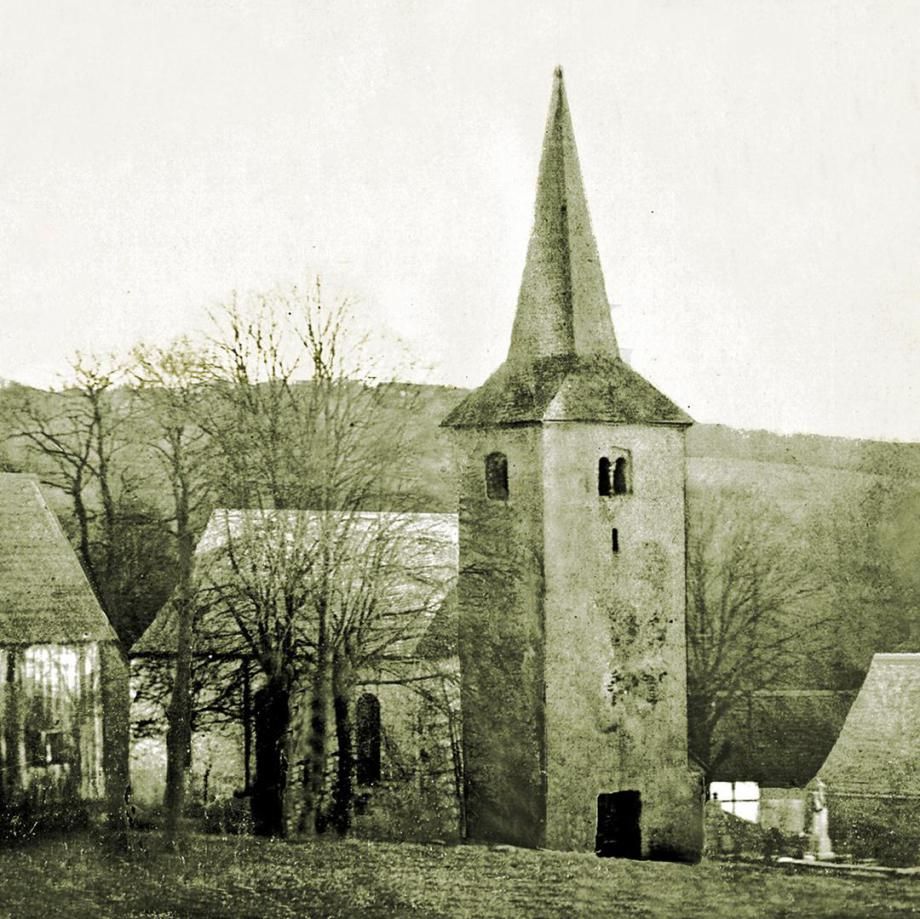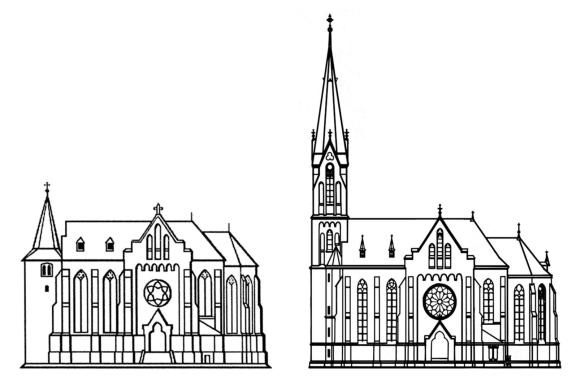St. Nikolaus Dürscheid Catholic Church
Kunibert Förster
Version from February 2021
The history
There was probably a simple half-timbered church or a prayer room in the courtyard of "Dursen" (also "Dursten"), as Dürscheid was originally called, very early on. The monastery and later
monastery of St. Maria im Kapitol in Cologne had owned a fiefdom in "Dursen" since the second half of the 11th century. This court soon became the administrative center for the numerous properties of the Cologne monastery in the Bergisches Land. The court, which regulated all property-related matters, met here.
The first stone church was probably built in the 13th century. The age of a wooden beam from the tower has been dated to 1280 ± 40 years.
The quarrystone tower with Romanesque windows and small embrasures has been preserved. The nave was renovated in
1727
after the roof had partially collapsed. The tower was secured with iron anchors with the year 1727 at the top, which led to the erroneous assumption that the tower had only been built in that year. The Johanniter in Herrenstrunden donated the timber from their rich forests. The
parish of Dürscheid, which was first documented as a
parish in 1351, had belonged to the parish of Herkenrath, which was
under the patronage of the Knights of St. John, since 1413. This
dependency only ended in 1816
when Dürscheid became an independent parish (again).
The church used to be surrounded by a churchyard with a wall and railings, which included an ossuary, 7 footstones and
around 150 gravestones, the oldest of which dates back to 1611.
Since
1880, there has been a new cemetery with a neo-Gothic cemetery cross above the village center towards Spitze. The ossuary and the old gravestones have - with a few exceptions - disappeared today. They are attached to the retaining walls facing the road. The mission cross on the north side of the church with a baroque corpus is worth seeing. Its origin is unknown, but experts estimate its age to be at least 200 years.
When the church became too small in the 19th century due to a significant increase in the population (improvement in agriculture, iron ore mining), the then pastor
Johann Voß
built a new church with a choir and wide transept
in 1895. It was the time of historicism and so the church was built in the neo-Gothic style according to plans by the then well-known church architect Wilhelm Sültenfuß. Only the old tower remained standing because the money ran out. The church was
consecrated by the priest in 1896; the
solemn consecration by the bishop did not take place until 1902.
As the space for the new church was limited in the longitudinal direction, the width was utilized, on the one hand by an unusually large width of the nave in relation to the length, which was, however, limited by possible problems with the vaults; on the other hand by the construction of a transept, which turned out to be almost as large as the nave; for example, it has almost 90% of the length and around 85% of the width of the nave.
Further stations of the church
Further stations of the church are:
- 1827 Installation of the first organ;
- 1925 and 1963 renewal of the organ;
- 1933 Installation of a warm air heating system;
- 1938 painting by the church painter Hans Heider from Siegburg; renovations:
- 1958 (war damage) and
- 1970 (general overhaul including masonry and foundations).
The bells were confiscated twice, namely in the First and Second World Wars, and melted down as cannons (in the second, even the over 400-year-old St. Nicholas bell, which had been spared in the first), and new bells were cast twice after the war and hung in the tower (1933 and 1956).
The once neo-Gothic design of the interior (painting, pulpit, communion bench, etc.) fell victim to modernization in the 1960s (as a result of the Second Vatican Council). Apart from the baptismal font, only the high altar has been preserved, which probably comes from a Belgian-Flemish workshop. The wings (unfolded) show scenes from the Passion of Christ (Jesus on the Mount of Olives, scourging, crowning with thorns and carrying the cross) and the figures of saints (some of which ended up in the attic).
The windows are a particular eye-catcher. The then parish priest Heinrich Pohl had them created and installed by the painter and glass artist Hans Lünenborg (Cologne) over a period of 30 years (1965 - 1987). They represent the seven corporal and seven spiritual works of mercy, which are symbolized by saints (or people who are considered saints). In addition to classic saints such as Martin of Tours or Bernard of Clairvaux, "modern" saints such as Edith Stein or Mother Teresa (still alive at the time) are also depicted. There are also figures from the Old Testament (Tobias and Judas Maccabeus) and even ancient Greek philosophers (Aristotle and Plato). Only the three choir windows date from before the First World War (Jesus on the cross; St. Nicholas saves the daughters of an impoverished nobleman from prostitution with a gift of money; the calling of disciples on the Sea of Galilee).
More recent times
The church has hardly undergone any changes in recent times. However, it has been overhauled several times (cleaning and renovation work, renewal of the paintwork, repairs to the roof and masonry, etc.). The church underwent its last major change in 2010/2011 when, in addition to a thorough renovation (especially of the roof, brickwork and interior), the altar was moved from the choir almost to the middle of the crossing. Together with the clearly structured, rather sparsely furnished interior, the result is a spatial effect focused on the center, i.e. the altar, which does not distract from the proceedings with any disruptive effects and therefore has a very positive effect on the atmosphere during church services.
In addition to the aforementioned altar and baptismal font, the church's furnishings today include a modern organ, a modern ambo with the symbols for the four evangelists, a matching candlestick for the Easter candle and apostle candlesticks on the walls. The Stations of the Cross were designed in the 1990s by the artist Marianne Haas, who lived in Marialinden at the time. Several statues of different origins and ages complete the decor: St. Nicholas, Mary with the Child, St. Joseph, St. Sebastian and the original statue of St. James from the chapel in Spitze. In addition to the baptismal font, a niche for storing the holy oils was recently added to the front right.
The church has been a listed building since 1984
(monument no. 5).
It has been part of the parish of St. Marien Kürten since 2010.
Sources:
Peter Opladen: Das Dekanat Wipperfürth, Verlag F. Schmitt, Siegburg 1955.
Heinrich Pohl: Sankt Nikolaus Dürscheid, Libertas Verlag, Wiesbaden 1966.
Lydia Kieven: Kulturführer Rheinisch-Bergischer Kreis, publisher: Bergischer Geschichtsverein, Abteilung Rhein-Berg e. V. and Rheinisch-Bergischer Kreis, Heider-Verlag, Bergisch Gladbach 1998.
Gerda Panofsky-Soergel: Die Denkmäler des Rheinlandes, Rheinisch-Bergischer Kreis, Vol. 1 - 3, Verlag Schwann Düsseldorf, 1972 - 1974.
Kunibert Förster: Dürscheid an der Dursch - Ortsgeschichte kurz gefasst, in: Kürtener Schriften 5, ed.: Geschichtsverein für die Gemeinde Kürten und Umgebung e. V., Kürten 2005.
Josef Büchel, Peter Gronewald: Bilder aus alter Zeit, Gemeinde Kürten, 3 Volumes, Meinerzhagener Druck- u. Verlagshaus, Meinerzhagen 1984, 1986 (Vol. 1+2); DFS, Brecher & Müller, Cologne 1999 (Vol. 3).
Municipality of Kürten: Monument list of the municipality of Kürten, monument no. 5.
Geschichtsverein für die Gemeinde Kürten und Umgebung e. V.: Von Wegekreuzen, Mühlen und Dolinen - Kulturhistorische Zeugnisse in der Gemeinde Kürten, Kürten 2009.








